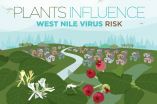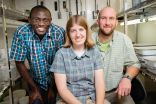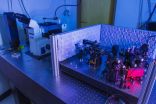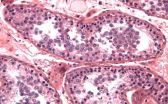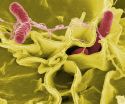(Press-News.org) CHAMPAIGN, Ill. -- A new study looks at how leaf litter in water influences the abundance of Culex pipiens mosquitoes, which can transmit West Nile virus to humans, domestic animals, birds and other wildlife.
The study found that different species of leaf litter in standing water influence where Culex pipiens mosquitoes deposit their eggs, how quickly the larvae grow, how big they get and whether they survive to adulthood. Because the mosquitoes feed on bacteria that grow on leaf litter, the team also measured how native and non-native leaf species influenced bacterial abundance and diversity.
The study is reported in the journal Parasites and Vectors.
When added to standing water, the leaves of two non-native, invasive plants, Amur honeysuckle (Lonicera maackii) and autumn olive (Elaeagnus umbellata), yielded significantly higher numbers of adult mosquitoes than other leaf species did, the researchers report.
"The invasive honeysuckle was definitely the highest quality habitat in terms of the adult mosquito emergence rates, even when you had very high densities of the larvae," said graduate student Allison Gardner, who led the research with University of Illinois entomology professor Brian Allan and Illinois Natural History Survey entomologist Ephantus Muturi. The INHS is a division of the Prairie Research Institute at the U. of I.
A third invasive plant, multiflora rose (Rosa multiflora) was associated with low numbers of eggs laid and low survival of the larvae, the researchers found.
The team also made an unexpected, but promising, discovery: One of the plants studied, a native blackberry (Rubus allegheniensis), seemed to encourage Culex pipiens mosquitoes to deposit a lot of eggs on the water's surface - but very few of the resulting larvae survived to adulthood.
"The blackberry was one of the most attractive habitats to the mosquitoes, but also one of the lowest quality habitats in terms of the larval survival rate," Gardner said.
"Blackberry was a really poor habitat: It took the larvae a long time to develop and the adult mosquitoes that eventually emerged were small," Allan said. "What's exciting about this is that it suggests that blackberry functions as a kind of ecological trap, enticing mosquitoes to lay their eggs in a place where the larvae are unlikely to survive."
This finding could lead to new, biological methods of controlling Culex pipiens mosquitoes, he said.
Two other native plants, elderberry (Sambucus canadensis) and serviceberry (Amelanchier laevis), had different effects on the mosquitoes. Elderberry attracted mosquitoes looking for a place to lay their eggs, and the larval survival rates were low, but not as low as for blackberry. The mosquitoes deposited the lowest number of eggs in water infused with serviceberry leaves, but the survival of the larvae was a fairly robust, 62 percent. (See graphic.)
The team also analyzed the bacteria that colonized the different leaf types.
"We wanted to understand the mechanism by which plants differ in their ability to support mosquito oviposition, development and survival," Muturi said.
Sites with more bacterial diversity had higher numbers of mosquito eggs than those with less diversity, the researchers found. But bacterial abundance, not diversity, was associated with better larval survival.
This finding could explain the unexpected role of blackberry leaves as an ecological trap, Muturi said. Blackberry leaf debris in water hosted a high diversity of bacterial species, but bacterial abundance was rather low, giving the developing larvae little sustenance.
"If you are a mother, you want your kids to develop in an area that has more resources, more food to eat," Muturi said. "But sometimes a mother makes a mistake and chooses the wrong habitat. An ecological trap is a mismatch between the choice that the mother makes and the quality of the habitat."
Future studies will explore whether blackberry leaves can be used to undermine the viability of disease-carrying mosquitoes, Allan said.
In the meantime, those working to stop the advance of invasive plants like honeysuckle and autumn olive have another reason to do so, Allan said.
"These are some of the most widespread invasive exotics in North America," he said. "Plants like honeysuckle are having very significant ecological impacts, displacing a lot of native species. And now we're seeing that some of them also enhance the transmission of a dangerous disease."
INFORMATION:
The U.S. Environmental Protection Agency, the Institute for Sustainability, Energy and the Environment at the U. of I., and the Illinois Used Tire Management Fund supported this research.
Editor's notes:
To reach Brian Allan, call 217-244-1341; email ballan@illinois.edu.
To reach Allison Gardner, email amgardn2@illinois.edu.
To reach Ephantus Muturi, email emuturi2@illinois.edu.
The paper, "Asymmetric effects of native and exotic invasive shrubs on ecology of the west Nile virus vector Culex Pipiens," is available online or from the U. of I. News Bureau.
Living with Type 1 diabetes requires constant monitoring of blood sugar levels and injecting insulin daily. Now scientists are reporting in the ACS journal Industrial & Engineering Chemistry Research the development of an implantable "artificial pancreas" that continuously measures a person's blood sugar, or glucose, level and can automatically release insulin as needed.
Type 1 diabetes, previously known as juvenile diabetes, affects about 1.25 million Americans. About 200,000 of them are under 20 years old. The condition arises when a person's own immune system destroys ...
MOOCs -- massive open online courses -- grant huge numbers of people access to world-class educational resources, but they also suffer high rates of attrition.
To some degree, that's inevitable: Many people who enroll in MOOCs may have no interest in doing homework, but simply plan to listen to video lectures in their spare time.
Others, however, may begin courses with the firm intention of completing them but get derailed by life's other demands. Identifying those people before they drop out and providing them with extra help could make their MOOC participation much ...
The production of petroleum from Canada's oil sands is on the rise with much of it destined for U.S. refineries. As the U.S. takes stock of its greenhouse gas emissions, scientists report in the ACS journal Environmental Science & Technology that the current oil sands production of fuels from "well-to-wheels" releases about 20 percent more carbon dioxide into the atmosphere than making gasoline and diesel from conventional crudes.
In 2013, the oil industry was producing nearly 2 million barrels per day from Canadian oil sands. By 2030, that number is expected to rise ...
JILA researchers have designed a microscope instrument so stable that it can accurately measure the 3D movement of individual molecules over many hours--hundreds of times longer than the current limit measured in seconds.*
The technology was designed to track the machinery of biological cells, down to the tiniest bits of DNA, a single "base pair" of nucleotides among the 3 billion of these chemical units in human genes. But the instrument could be useful well beyond biology, biochemistry and biophysics, perhaps in manufacturing.
JILA is a partnership of the National ...
GRAND RAPIDS, Mich., June 24, 2015 - Researchers at Spectrum Health Helen DeVos Children's Hospital have completed the first clinical trial of a new treatment for children suffering from neuroblastoma. In a clinical trial led by Giselle Sholler, MD, pediatric oncologist at Helen DeVos Children's Hospital and the Neuroblastoma and Medulloblastoma Translational Research Consortium (NMTRC), DFMO, an investigational agent, showed minimal side effects with long-term survival of three patients. This is the first clinical study of an oral dosing form of DFMO in any pediatric population. ...
Scientists have at their disposal a way to explore the possible prevention of genetic diseases before birth. But should they? Currently, the most promising path forward involves editing the genes of human embryos, a procedure rife with controversy. An article in Chemical & Engineering News (C&EN), the weekly newsmagazine of the American Chemical Society, parses the explosive issue.
Britt E. Erickson, a senior editor at C&EN, reports that at least one team of scientists has already published a study on altering disease-related genes of human embryos. The experiment was ...
In the most severe form of male infertility, men do not make any measurable levels of sperm. This condition, called azoospermia, affects approximately 1 percent of the male population and is responsible for about a sixth of cases of male infertility.
Oftentimes men with azoospermia don't know the underlying cause of their condition. But new research led by University of Pennsylvania scientists suggests that mutations in an X chromosome gene called TEX11 are responsible for a significant number of cases of infertility -- an estimated 1 percent of cases of non-obstructive ...
Complex magnetic structures are at the heart of promising new materials for devices in "spintronics", a field of research aiming at more energy efficient data storage and processing. A prominent example is the so-called spin valve, where the magnitude of the electrical current passing through a device is very sensitively dependent on its magnetic configuration. These configurations can be readily controlled by a magnetic field in artificial layer systems, resulting in the giant magnetoresistance effect (GMR), a discovery rewarded with the 2007 Noble price in physics to ...
College Park, Md. -- Extreme heat and precipitation events, which are expected to increase in frequency and intensity due to climate change, are associated with increased risk of Salmonella infections, according to a study led by researchers from the University of Maryland School of Public Health. The study is the first to provide empirical evidence that Salmonella infections related to extreme weather events are disproportionately impacting those living in the coastal areas of Maryland.
"We found that extremely hot days and periods of extreme rainfall are contributing ...
When ecologists gather in Baltimore, Md., this August for the 100th Annual Meeting of the Ecological Society of America, special attention will fall on the local Chesapeake Bay watershed, with field trips and research presentations exploring its rich wildlife and social history. At symposia, poster exhibits, and site visits, ecologists will have opportunities to discuss the latest research and experiences working with stakeholders in the region to improve the health of the nation's largest estuary.
Chesapeake Bay bears a heavy pollution burden from the growing metropolitan ...
